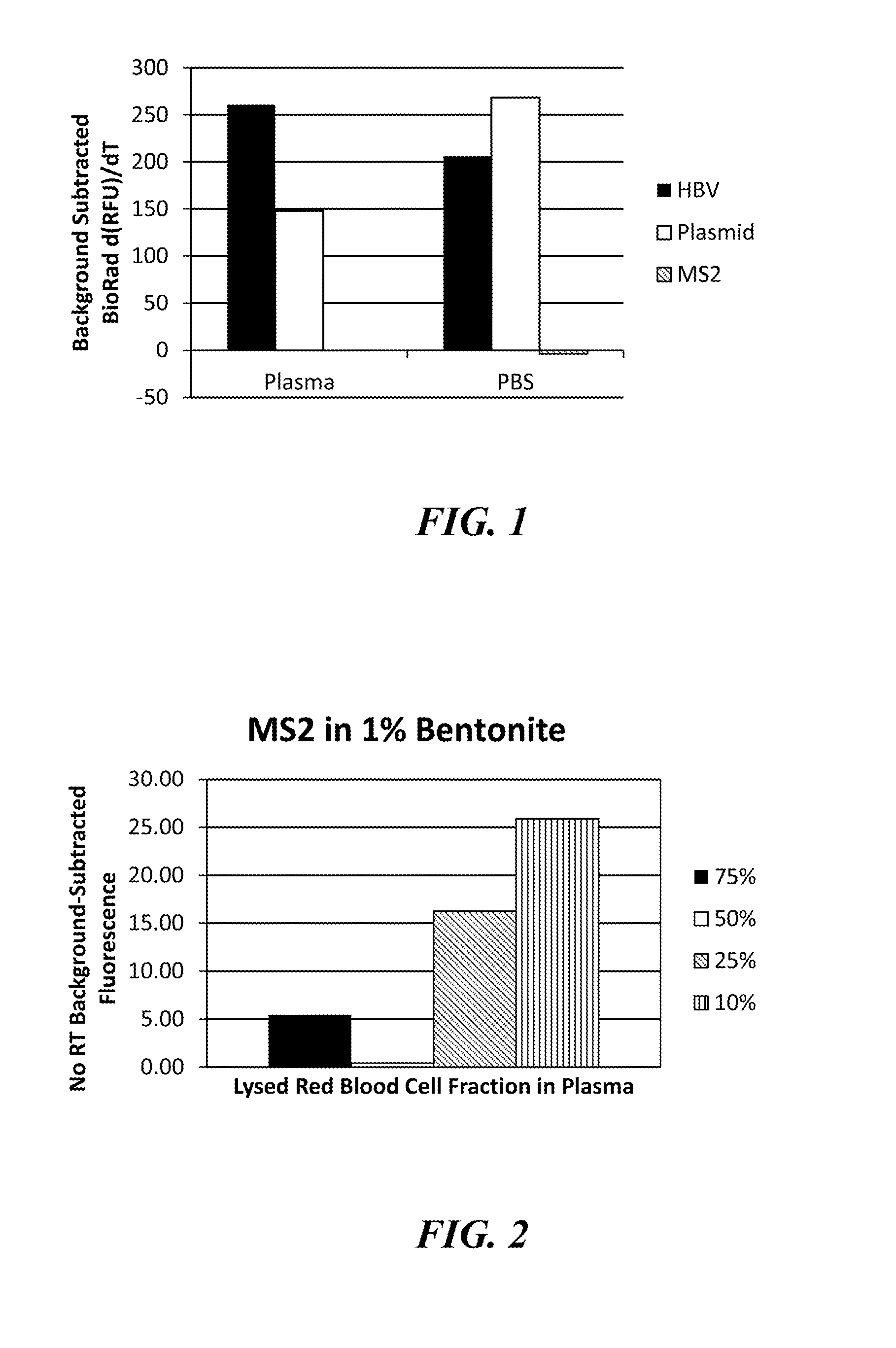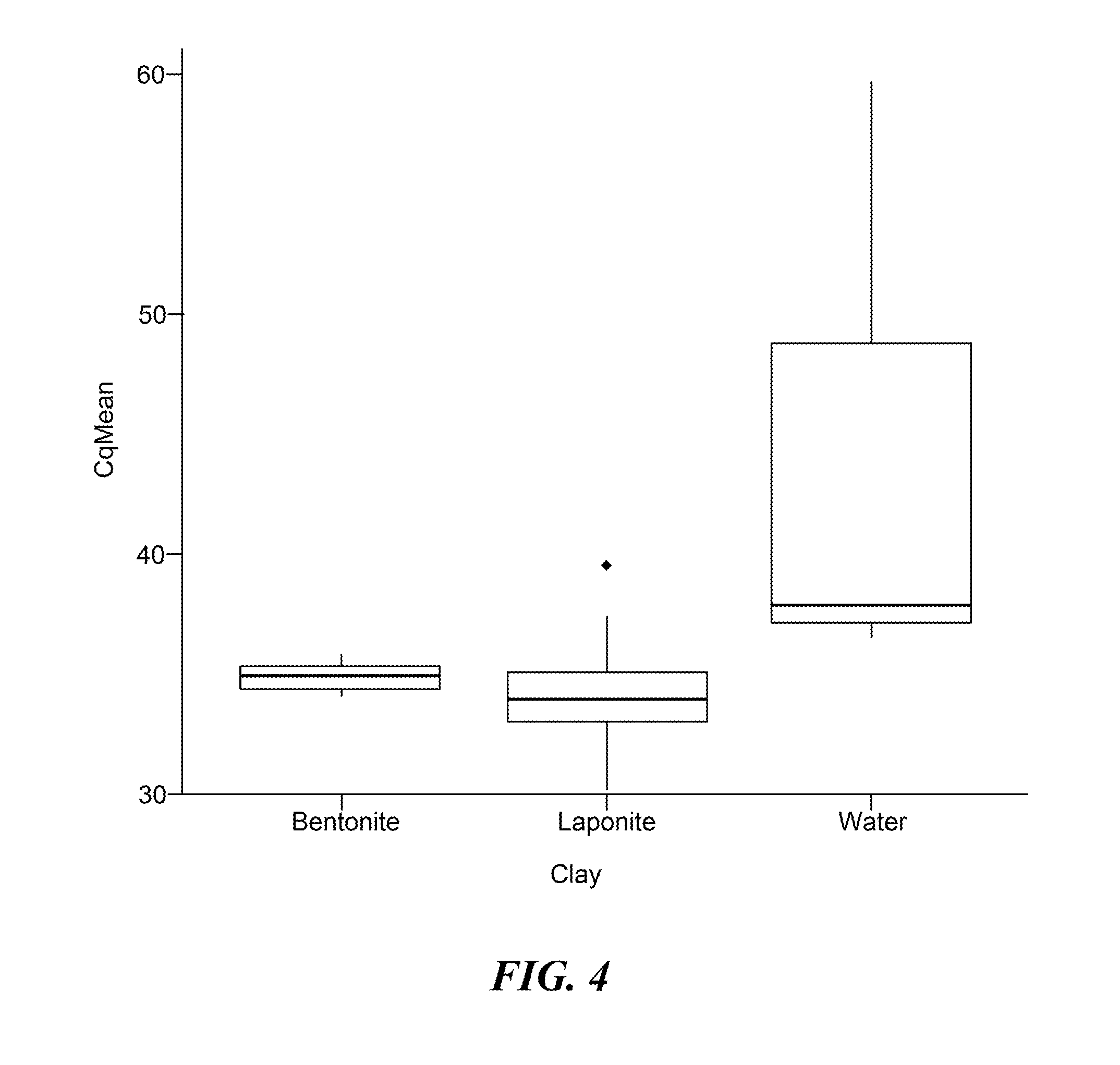Methods for preparation of nucleic acid-containing samples using clay minerals and alkaline solutions
a nucleic acid and clay mineral technology, applied in the field of processing samples, can solve the problems of many downstream analytic procedures, interfere with and/or inhibit, and the nucleic acid begins to be destroyed, so as to achieve the effects of simple, quick, and low contamination risk
- Summary
- Abstract
- Description
- Claims
- Application Information
AI Technical Summary
Benefits of technology
Problems solved by technology
Method used
Image
Examples
example 2
Sample Preparation for DNA and RNA Target Detection Using Alkaline Lysis with Various Clay Minerals
[0075]This Example demonstrates that a variety of clay minerals are effective in adapting the alkaline lysis protocol to the preparation of samples for detection of both DNA and RNA targets.
[0076]In this Example, the following minerals were assessed: the phyllosilicate clays, bentonite, Fuller's earth, and montmorillonite (MK10), and the magnesium silicate, talc. Human plasma samples were prepared as described above and spiked with either the MS2 RNA phage at 106 pfu per sample or the HBV DNA virus at 1,600 or 160 IU / sample. Each clay was added to the plasma sample at a final concentration of 1, 10, 20, or 40 mg / mL and shaken until the clay was thoroughly hydrated (approximately five minutes at room temperature). The clays were removed from the plasma samples by centrifugation, and the samples were subjected to alkaline lysis by adding 1M potassium hydroxide (KOH) to a final concentrat...
example 3
Preparation of a Sample Derived From Whole Blood for Detection of a RNA Target
[0078]This Example demonstrates that a sample preparation protocol based on clay lysis can be used to generate an extract of whole blood for the detection of an RNA virus.
[0079]It is well known in the art that whole blood contains factors that interfere with PCR analysis. This raises challenges in using unfractionated blood as a sample in nucleic acid-based diagnostic assays. To investigate whether clay may overcome these intrinsic inhibitory properties, whole blood spiked with plasma derived from patients infected with Hepatitis C virus (HCV) was used as a starting material for analysis. In this experiment, either bentonite or the synthetic swelling clay, laponite, was used for sample treatment prior to alkaline lysis. Clay was dissolved in water and added to the HCV-spiked whole blood samples at a final concentration of 0.63-1.33% (wt / vol). Samples were mixed at room temperature for 5-10 minutes and the ...
example 4
Simultaneous DNA and RNA Extraction with Clay and Alkaline Lysis
[0081]This Example demonstrates that a protocol based on clay treatment followed by alkaline lysis can be used to prepare a single sample for detection of both a DNA and a RNA target.
[0082]In this experiment, human blood was spiked with serum from both a patient infected with HBV and a different patient infected with HCV. The virus-spiked blood samples were pre-treated with bentonite, diatomaceous earth, or laponite clay or no clay as a control. This was followed by alkaline lysis, as described above. Lysed samples were used directly in qRT-PCR reactions without any further extraction or purification steps to detect HBV- or HCV-specific sequences.
[0083]The Cq data are presented as box plots in FIG. 5, which demonstrate that each of the three clays significantly improves the detection of both RNA and DNA targets present in the same preparation of whole blood sample lysate. Taken together, the data presented in these Exam...
PUM
| Property | Measurement | Unit |
|---|---|---|
| particle size | aaaaa | aaaaa |
| pH | aaaaa | aaaaa |
| concentration | aaaaa | aaaaa |
Abstract
Description
Claims
Application Information
 Login to View More
Login to View More - R&D
- Intellectual Property
- Life Sciences
- Materials
- Tech Scout
- Unparalleled Data Quality
- Higher Quality Content
- 60% Fewer Hallucinations
Browse by: Latest US Patents, China's latest patents, Technical Efficacy Thesaurus, Application Domain, Technology Topic, Popular Technical Reports.
© 2025 PatSnap. All rights reserved.Legal|Privacy policy|Modern Slavery Act Transparency Statement|Sitemap|About US| Contact US: help@patsnap.com



